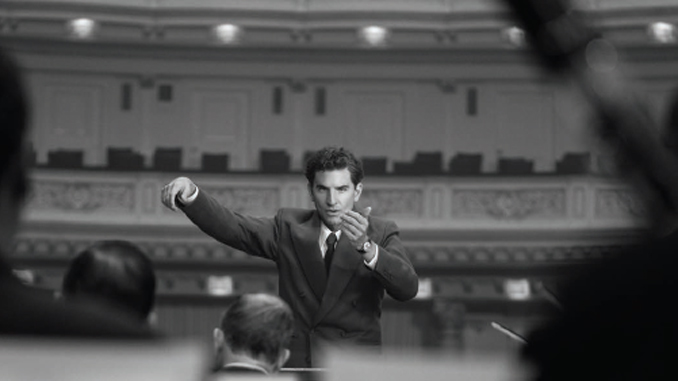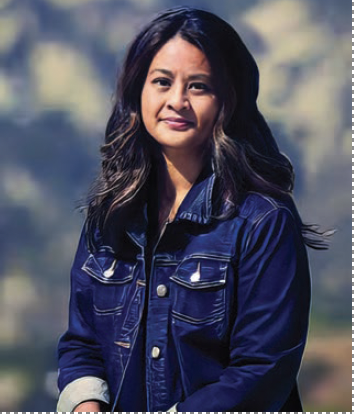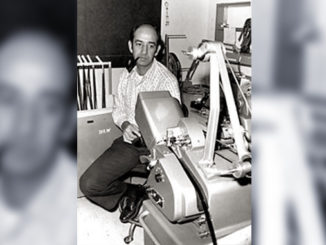
By Peter Tonguette
In the dictionary, the noun “maestro” is a term used for a classical-music conductor. The word confers a certain authority: the maestro, or conductor, is the center of gravity and the center of attention. After all, the conductor stands at the podium, and until he or she taps the baton and motions to the assembled orchestra players, no music is made. There is a bit of magic to being a maestro: he or she is the person who summons forth sounds from an otherwise silent page.
The new Netflix drama “Maestro” takes as its subject one of the most notable maestros in the annals of American music, and certainly one of the most visible: the conductor Leonard Bernstein. As played by director, producer, and co-writer Bradley Cooper, Bernstein is a volcanic, volatile, and unforgettable force — not just a gifted conductor, but a composer of renown (“Candide,” “West Side Story,” the score to “On the Waterfront”), a TV host (“Young People’s Concerts”), an attentive father, an adoring husband to Felicia Montealegre (played in the film by Carey Mulligan), as well as an enthusiastic participant in affairs: as the film opens, Bernstein, who was bisexual, is shown in the throes of a intense relationship with an old friend, the clarinetist David Oppenheim (Matt Bomer).
Yet the movie “Maestro” did not arrive on screens as the product of a single person. Perhaps Bradley Cooper was the conductor of the project, which was co-written with Josh Singer and which had at one point been planned as a directorial vehicle for Martin Scorsese (who remains a producer on the picture). But the film itself came to life thanks to the creativity and industriousness of a highly committed creative team, including picture editor Michelle Tesoro, ACE, executive music producer and supervising music editor Jason Ruder, and sound designer and supervising sound editor Richard King.
Tesoro first entered Cooper’s orbit following her work on Sean Penn’s film “Flag Day” (2021), which she had helped recut. Cooper had given Penn notes on various passes on the film.
“When Bradley saw my pass, which was the final pass of the film, he asked Sean, “Who edited this?’” Tesoro said. “At the time, he was still developing ‘Maestro,’ and he wanted to know if I’d be interested in helping him work on a sizzle reel, which we ended up calling a proof of concept.” Tesoro put together test footage that displayed the convincing makeup designed by Kazu Hiro to transform Cooper into Bernstein at different points in his 72 years. (The conductor was born in 1918 and died in 1990.)
Although the “maestro” in the title is Bernstein, Cooper never intended to make a movie focused on a godlike conductor. Instead, the script gave equal time — maybe even more than equal time — to Bernstein’s wife Felicia, who had to navigate her love for her husband with the knowledge of his bisexuality. “Bradley set out to make a movie about marriage,” Tesoro said. “When he came aboard to be a co-writer, he and Josh rewrote the story to focus on Felicia and the marriage. That was what he found to be the most compelling story that he could tell.”
During postproduction, Tesoro never had to strain to give weight to Felicia’s side of a scene because her perspective was already central to the script. “Sometimes, we really leaned so heavily into Felicia that it seemed like it was all her story,” she said. “Then we had to backtrack and maybe put Lenny more into it to have the balance. Even if they did some improvisational scenes, it was always leaning towards her, or the two of them, or the family as a whole.” Bernstein’s three children are played by Maya Hawke, Gideon Glick, and Alexa Swinton.
The film, which was photographed by Matthew Libatique, ASC, transitions between 1940s-era black-and-white sequences in the 1.33:1 aspect ratio, later color sequences also in 1.33, and a few bookend color segments in 1.85. The height of the 1.33 aspect ratio was especially useful during scenes of Bernstein at the podium. “When he’s conducting, you can really take advantage of the height,” Tesoro said.
Although the choice to alter the size of the image, as well as to incorporate both black-and-white and color, was a bold one, Tesoro said that her goal was to make the transitions seamless. “Typically, I always aim for the invisible,” she said. “I don’t want to lose your attention. We experimented with certain kinds of long dissolves or superimpositions, but the film would just kick it back, like, ‘This is not what I want.’” Cooper favored long takes that observed the complicated characters instead of commenting on them. “It’s a more observational style, instead of saying, ‘Oh, now look here,’” Tesoro said. “He always felt that if we had more coverage, it would feel like a movie and it wouldn’t feel like you’re witnessing real people and real situations.” A greater degree of intercutting between the black-and-white and color sequences was originally anticipated, but during postproduction, it was decided to let the two sequences play out with a minimum of switching back and forth.

The shooting schedule ran from May through the end of July 2022, and then picked up again in September when additional locations became available. “I was always very close to picture,” Tesoro said. “That was probably informing [Cooper] of how things were coming together.” The interruption in filming offered the unique opportunity for director and picture editor to live with the film as it was coming into focus. During the pause, Cooper had the chance to take stock of which to-be-shot scenes were needed and which possibly weren’t; in the end, one sequence was scrapped altogether. “We kind of knew what the movie was and were really honing it,” Tesoro said. Each time filming picked up again, Tesoro was left even more impressed with the makeup design. “Every time he went back, the makeup just got better and better,” Tesoro said, pointing to one of the last scenes shot: an interview with a very aged Bernstein in a red sweater. “When I saw it, I went, ‘Holy moly.’ Many times with makeup, there are wig fixes we have to do. There are little things we have to do. Here, there was nothing we had to do. We color-timed it, which you would do with someone’s regular face.”
In fact, the interview sequence was so compelling — and provided such an insight into the character of Bernstein — that Cooper and Tesoro moved the scene to the very start of the picture (which would have originally opened with a scene, still in the film, of Bernstein being invited to conduct the New York Philharmonic). “The red sweater scene was meant to go at the very end of the film in the timeline of the film,” Tesoro said. “But we were looking for a way to ground the film in the story of Lenny and Felicia, so the byproduct of it is you are confronted with the makeup, with what Lenny looked like at that time. This was a way of saying: “This is Lenny, not Bradley Cooper.’”
Throughout the film, major structural elements stayed the same, but the film was refined and individual scenes altered or cut until late in the process. Tesoro began to see the film as a bit of a symphony of Bernstein’s life. “The music of Leonard Bernstein, as we used it in the film, completely dictated the editing,” Tesoro said. “That doesn’t mean that we edited the picture to the music, but in thinking about his music and thinking about how we were editing the story together.” The film uses Bernstein-composed music as its score, some of which Cooper had already spotted and some of which the director was saving for the right moment. “It was more about waiting for the right moment when we had the right sequence where we wanted to try to add music,” Tesoro said. “We’d go through the cues that weren’t used, or weren’t spotted for other places, to see which one would make sense not only in the timeline of Bernstein’s life but the emotion and mood that the cue would bring.” The interplay between music and picture was akin to a “conversation,” the editor added.
In several sequences, the music itself takes center stage, especially a performance of Gustav Mahler’s “Symphony No. 2” (the “Resurrection Symphony”) at the Ely Cathedral in England — a performance that, at Cooper’s insistence, was recorded live. Cooper turned to Ruder, the music editor with whom he had worked on his first feature as a director, “A Star Is Born” (2018).
“I got an early copy of the script that was in progress, and he said, ‘Look, we’ve had so much success on ‘A Star Is Born’ with live vocals and doing things live on set. What do you think about tackling this in the same fashion?’” Ruder said. “I got excited and extremely scared at the same time. I said, ‘You mean with full orchestra doing Leonard Bernstein?” . . . It sounded absolutely amazing, and it sounded like one of the biggest challenges I’ve ever heard of in our line of work.”
Cooper decided that any music shown to be performed live on camera would be recorded live on set. “We never let go of his vision: ‘If we see it, we’ve got to capture it live,’” Ruder said, and that especially applied to the sequence of Bernstein conducting Mahler at the Ely Cathedral. “The tech scout was an intricate piece of the puzzle,” Ruder said. “Ely is not the best-sounding [venue]. It’s beautiful, but it’s just like this enormous cavern. We were like, ‘This is going to be hard to record.’”
The filmmakers partnered with classical recording engineers at a company called Classic Sound. “I said, ‘Have you recorded anything at Ely?’ And they said they had done years ago a couple of recordings,” Ruder said, noting that Classic Sound uses Puremix rather than Pro Tools. “I thought, ‘These are our guys,’” Ruder said. “We discussed how to sling microphones. We figured out whether any microphones would be in frame. There were a couple you could see in the archives [of the actual performance] . . . . We came up with a strategy to shoot, and it actually, magically, worked out.”
When it came time to film the scene, Cooper, inhabiting Bernstein, stood in front of musicians from the London Symphony Orchestra, as well as a chorus of singers, who then performed selections from the Mahler symphony. “We kind of mapped it out roughly, because we were short on time,” Ruder said. “Bradley was very good about: ‘This is the section. Let’s map out the measures.’” Multiple cameras, used in several different setups, captured the scene. “When you have that many players and singers live, it’s kind of a wild animal,” Ruder said. “It was really down to a few magic takes, to be honest with you.”
For scenes that used Bernstein’s music as score, however, Cooper and Ruder discussed using the original masters from the composer’s recordings. “All we had is stereo masters,” Ruder said. “I thought, ‘Surely some sort of multi-tracks that exist, and that might help us make a little more of a 7.1 or an Atmos mix.’ But we really couldn’t get our hands on them.” Then the idea emerged for the London Symphony Orchestra to recreate the pieces. Conducting consultant Yannick Nezet-Seguin used the actual Bernstein recordings, which were being used as the film’s “temp score,” as a reference. “Yannick really studied the scenes that we had put together and the actual recordings that we were working with,” Ruder said. “At that point, we were able to do an Atmos scoring session and bring it back to a dub stage.”
The sound world of the film often had to be subservient to the music, as in a dream-like scene in which Lenny and Felicia find themselves onstage in a performance of the classic Bernstein-scored ballet “Fancy Free.” “With those more dreamlike or imaginative moments, like ‘Fancy Free,’ there’s very little Foley, if any,” Richard King said. “It’s all production sound and it’s all music. Even a lot of the production movement, like footsteps, were taken out.” During the Mahler scene, too, any background sound has been eliminated. “The world kind of comes back after [the musicians] finish,” King said. The scene was a delightful detour for Tesoro as well. “I love cutting ballet and dance,” she said. “I worked on a television show that was all ballet dancers years ago. You have to be able to see the whole body and know where to go. It was such a joy to cut this sequence because I knew how to do this. The music is always there, and it’s really a little microcosm of their story.”
On the other hand, scenes of the Bernsteins’ day-to-day domestic existence were full of the everyday noise of life. “There are several different locations that we are in in Connecticut and Long Island and Manhattan, and we have a good sense of where we are sonically,” King said, also pointing to scenes at the Tanglewood music venue in Massachusetts, where Bernstein conducted and taught. “Tanglewood had its own kind of sound to it. You’re using different birds and different types of wind through different types of trees,” King said.
One especially impressive scene has very little sound at all: a devastating moment when Felicia sits in a doctor’s office, her husband beside her, to learn that she has breast cancer. “Everybody knows the cold feeling of a doctor’s examination room,” King said. “Foley in that scene was really important — just the contact between Felicia and Leonard. They’re holding one another and touching one another and hugging after she gets the news. It’s a very emotional film.”
And it’s a picture that continued to evolve until the very end. “It’s like a sculpture,” Tesoro said. “You have to start off with this idea of what it’s supposed to be, and as you continue to carve, things just start to become more clear every time. You have to go through the process of all these steps that come in between. Or us, even during the last two months, there were certain puzzles that hadn’t been solved.” Two sequences that originally stood independent of each other — of Lenny ending his relationship with David, and of Lenny talking with Felicia about getting married — are now intercut. “But intercutting the scenes a little bit more, you’re seeing more clearly the dissolving of the relationship with David into something else, but you’re also seeing the evolving of the relationship with Felicia,” Tesoro said.
Perhaps it’s even fair to say that the maestro was overseeing the production — from afar.
“The whole goal was: ‘How do we keep Lenny’s heartbeat and human nature alive through the whole thing?’” Ruder said. “That was the goal from day one, five years ago.”






